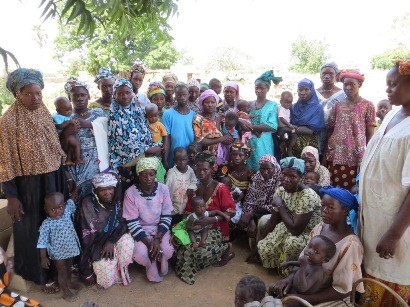
Katouma, 48 months, is amongst the cleanest, happiest and most active children of the many gathered with their mothers in Tion, the Ségou region of Mali. The mothers discuss a newly introduced approach to nutrition and the benefits it has brought to their households.
“Before the [program], Katouma was always sick and crying and didn’t have energy,” said Katouma's mother, Kadija Konta. “Now look at her!”
This community-based approach, called Positive Deviance/Hearth, identifies "positive deviances," or practices, that allow women to improve and maintain their children’s nutritional status by using locally available foods and good household practices at the “hearth,” or home. In 2013 alone, 88 percent of the 847 children identified as underweight gained weight as a result of these practices.
Katouma lives in the Ségou region, plagued with the highest prevalence of acute malnutrition in southern Mali. In 2013, an estimated 11.9 percent of children under 5 suffered from acute malnutrition. To address these challenges, USAID supports this development food assistance program implemented by Catholic Relief Services to improve nutrition and reduce food insecurity.
After attending Hearth training in April and May 2013, Konta put into practice improved household hygiene practices such as keeping kitchen utensils and eating areas clean, and washing hands prior to food preparation, eating or feeding young children, and after using the latrine. Konta also learned how to prepare nutritious recipes including enriched porridge and soup with meat to improve and maintain the nutritional status of Katouma and her other young children. Katouma is one of dozens of children in Tion who participated in USAID-supported Hearth activities in addition to more traditional malnutrition screening and treatment activities delivered through local health centers.
Five months after Hearth activities ended, it was clear that all of the mothers continued to take the advice to heart. “We can’t even compare the difference in our children before and after the Hearth,” said one mother.
Female community leaders are encouraging others to make positive daily changes even after the project ends. Fathers were also briefed on the approach before the activities began and have noticed the benefits. The mothers noted that their husbands are happy and have more affection for their children. Improving family nutrition practices will also lead to less household health costs and result in greater food security.
Other project activities are designed to allow mothers to continue to provide good nutrition to their children from locally available foods, even during the lean season. A community safety net was in place prior to the start of the project. It was comprised of community contributions of staple grains following the harvest and designed to provide food to families of undernourished children in Tion, but contributions were not sufficient.
Following Hearth activities in the community, however, members were more aware of the positive results of their contributions and the community safety net was revitalized. Men provide local products and small monetary donations for ingredients such as meat and spices so the Hearth groups have the resources they need. Crop sales from a project-supported garden plot allows community members to increase their revenue to purchase other healthy ingredients. A portion of the improved millet production from these community plots also goes back to the Hearth groups to create nutritious recipes.
The Hearth approach was implemented in over 21 communities most affected by malnutrition in 2013 and helped rehabilitate 746 underweight children. It continues to be introduced in a growing number of communities in 2014. Thanks to USAID support, this program, which started in 2008 and ends in late 2014, contributes to the improved food security and nutritional status of over 203,000 people in 205 Malian communities.







Comment
Make a general inquiry or suggest an improvement.